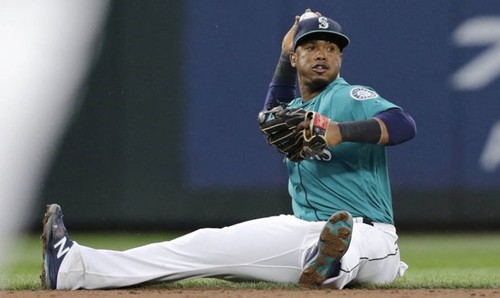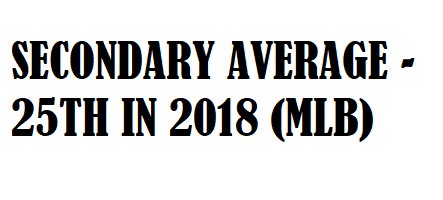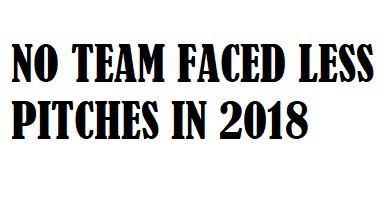
Seattle is crunching through more than a decade and a half of professional sports longest, active playoff drought. Jerry Dipoto – the Mariners current GM, dated to the culmination of the 2015 season -- has breathed life into this organization via Jean Segura and Mitch Haniger; among others. However, Seattle’s resurgence comes among rising payrolls and with that; a landscape harsher of those lacking depth and the need to re-tool.
In the era of ‘Sabrmetrics’, as we currently partake – being the study of the body of a baseball game or season -- organizations, and their players, are held to a higher standard than the generic ‘good game’ rhetoric you see in post-game interviews. That is where this article fits in.
It's undeniable that the Mariners -- in an overly competitive American League landscape, despite mounting frustration -- exceeded expectations; clearing a tick under 90 wins in 2018. Mr. Pythagorean exclaimed 77 wins, likely due in part to the landscape – mentioned above – but did not account for the Mariners spending the majority of the first-half on a bullish run.
As Dipoto & Co. cannot dictate the volume of the market or their competition, we – as the Mariners community – should investigate the components needed to turn the corner into perennial post-season competition. At the same time, investigating organizational short-comings that other clubs are using to successfully navigate Major League Baseball’s hauntingly long, excessive schedule.
It is unclear, being months removed from the proximity of the coming season, of where the Mariners organization is looking to take their opening day payroll. What is clear; Seattle has nine players in arbitration. Of notable contribution in this group are arms James Paxton and Alex Colome; whom, combined are expected to earn around $6MM in payroll additions. It is fairly safe to forecast that the majority of the payroll lax Seattle would see from Nelson Cruz departing will be recycled on contract maintenance; rather than into the free agency market.
Dated to their entrance of a cable contract with DirectTV, the Mariners have increased their opening day payroll 7.25% each of the past four seasons -- or $11MM. As this contract is inked far into the future, and given the costly; competitive landscape -- of which keeps arising in this article -- much of the same can be expected in 2019.
In holding players – and journalism, to be honest – outside that ‘good game’ rhetoric mentioned before; let’s take a look at three areas of a baseball season that can go unseen; but more specifically, the Mariners participation in these areas last season.

Often regarded as the baseball statisticians equivalent of batting average. Through dividing Walks + (Total Bases - Hits) + (Steals - Caught Stealing) by At-Bats; secondary average factors down a series of outcomes rather than focusing on a static result. In the classical sense of batting average, this result, is the hit. Secondary average resonates within the ‘Sabrmetric’ community due to baseballs archaically long seasons being best described, honestly, as a series of outcomes.
Current Mariners Chairman John Stanton said it best;
“I believe winning is the result of probably hundreds and thousands of little things done right,”
Seattle concluded the 2018 season tied alongside the lowly Balitmore Orioles for the 25th overall secondary average in Major League Baseball, at .239. Those to conclude the season with a lower mark; the Royals, Tigers, Marlins and Giants. Alike to the majority of baseball’s non-cinderellla statistics; the Mariners struggles were a top-down affair.
Lead-off hitter Dee Gordon logged the lowest secondary average of ALL qualified (.129) hitters in Major League Baseball. This is further compounded when noted that Seattle’s second lowest contributor was Jean Segura (.181) – Seattle’s mainstay two-hole hitter last season – whom took home baseballs eighth lowest mark. While it cannot be denied that Segura was a positive contributor; secondary average, in part, defines dynamic baseball. This rolls back to the previous series of outcomes remark; clubs experience a higher number of outcomes at the top of their lineup; period.
Not a believer in secondary average? Check it out.
The five highest American League secondary average marks for the 2018 season; the Yankees, Red Sox, Athletics, Indians and Astros. Also known as the five teams to represent the AL into October. Additionally, three of the other five spots in the Major League Top 10 include National League post-season clubs; Rockies, Dodgers and Brewers.
FA Target – St. Louis Cardinals 1B Matt Adams.
Rumblings of Ryan Healy in Tacoma (AAA) and Nelson Cruz in free-agency could lead Adams to the Mariners door-step. That’s another article; however, Adams carried a .327 secondary average throughout last season and sports a lifetime .272 mark. His pension for pinch-hitting – even listed as one of his positions at Baseball-Reference -- acumen at first-base and ability to track a fly-ball in the outfield would sit well in Seattle.

As Seattle transitions from work-horse Felix Hernandez to James Paxton -- work-horse moniker not included – Seattle is looking at a glaring statistic in their rotation that goes beyond the inexperience of Wade LeBlanc, Marco Gonzales’ unmistakably weak second half and James Paxton’s’ overall health. That is the business of pitching to contact.
Seattle – as a club – threw less pitches than any other Major League club in 2018. Despite this; the organization recorded the second highest percentage of strikes thrown, which isn’t altogether damning, until it’s paired with the fifth highest (tie) contact percentage and eighth highest balls-in-play percentage against in baseball. Here’s the deal – and why this could be an issue next season.
James Paxton threw to the 14th lowest contact percentage in the Major Leagues last season, as well as sporting the sixth lowest balls-in-play percentage. Pitchers with lower marks last season, include; Chris Sale, Blake Snell, Max Scherzer, and Jacob DeGrom. Ready to become Seattle’s ace; however, unlike a number of the arms above, Paxton hasn’t displayed the ability to stay healthy to log the number of quality starts needed to staple a rotation. An unhealthy Paxton – should he be -- paired with a quiet off-season leaves the Mariners in dangerous waters; even inside pitcher friendly Safeco Field.
Of note, Seattle’s Mike Leake was exceeded -- for American League arms -- only by 45-year-old Bartolo Colon in a number of categories from last season, to include: contact percentage and balls-in-play percentage against.
FA Target – New York Yankees RHP Lance Lynn.
While he was a much stronger pitcher in New York in the second half of the season, rather than the first half, spent in Minnesota; Lynn will go into 2019 with the least sexy season of his career on record. Postseason performance pending; this is a plus for potential suitors viewing his $12MM current tag. Lynn misses’ bats and registered a paltry 25.8 balls-in-play percentage last season.
FA Target– Houston Astros RHP Charlie Morton.
Few years the elder of Lance Lynn and more familiar with the American League West landscape; Morton allowed the 14th lowest balls-in-play percentage last season and, additionally, joined James Paxton among the lowest 20 qualified pitchers for contact against. In the habit of signing single year contracts and currently $5MM cheaper than Lynn; Morton, over the course of his career; his strongest years – at quick glance – have come in the American League.
FA Target - Chicago Cubs LHP Justin Wilson
An arm for the bullpen; Wilson can be wild but has allowed, now in consecutive seasons, a balls-in-play percentage below 20%. An additional left-handed reliever would be a boon for this bullpen which currently lists Zach Duke -- also a FA -- alongside Roenis Elias as the Major League clubs sole left-handed options.

One thing all professional sports have in common is competition. Part of the puzzle, as these sports all feature fixed time frames for completion – nine innings, four quarters, and so on -- is getting inside the head of the opposition. In baseball, the way to do this is characterized no better than pitch count.
Momentum in a three game -- or four game - series can turn simple as an unexpected pitching change. Over the course of last season, no Major League club faced less pitches than the Seattle Mariners. The total – tallying 23,415 – clocks in excess of 2,500 below that of the World Series bound Los Angeles Dodgers and nearly 2,000 short of the second-half wunderkind Oakland Athletics.
Of these minimal chances; the Mariners put the Major Leagues highest percentage into play while recording the lowest run total per game – 4.18 R/G -- of all clubs to finish the season with a winning record.
Once again – as before, not damning on its own – Dee Gordon (3.38) and Jean Segura (3.49) are Seattle’s lowest contributors, this time, in relation to pitch count. As stated previously; these statistics are not meant to put a limit on Segura’s contribution but are being highlighted to notate that with a little retooling Seattle could maximize the outcomes available at the front of their lineup.
Of note, Ryan Healy clocked in as the third unlikeliest candidate in Seattle to face more pitches in any given plate appearance; just a tick higher than his predecessors at 3.64.
FA Target – Atlanta Braves OF Nick Markakis.
One of few players to make an appearance in all 162 games this season – at 34-years-old, none the less – Markakis spent the majority of his career in the American League. Given a solid performance last season; the veteran outfielder likely earned a multi-year contract, in total excess of his current $11MM price tag. While not spending the majority of his four National League seasons at the top of a Major League lineup; Markakis has logged over 300 games played from the lead-off and two-hole position over his career. Cruz out; Markakis in?
This is not a summation or a checklist for Seattle to tick; returning to the post-season upon completion. However -- and I have to mention the landscape, one last time -- Major League baseball has serviced the masses for this long due to their ability to field a dynamic, different product; year after year. Seattle needs to become one; whether by adoption of techniques applied by others or by finding their own toolset.

Comments